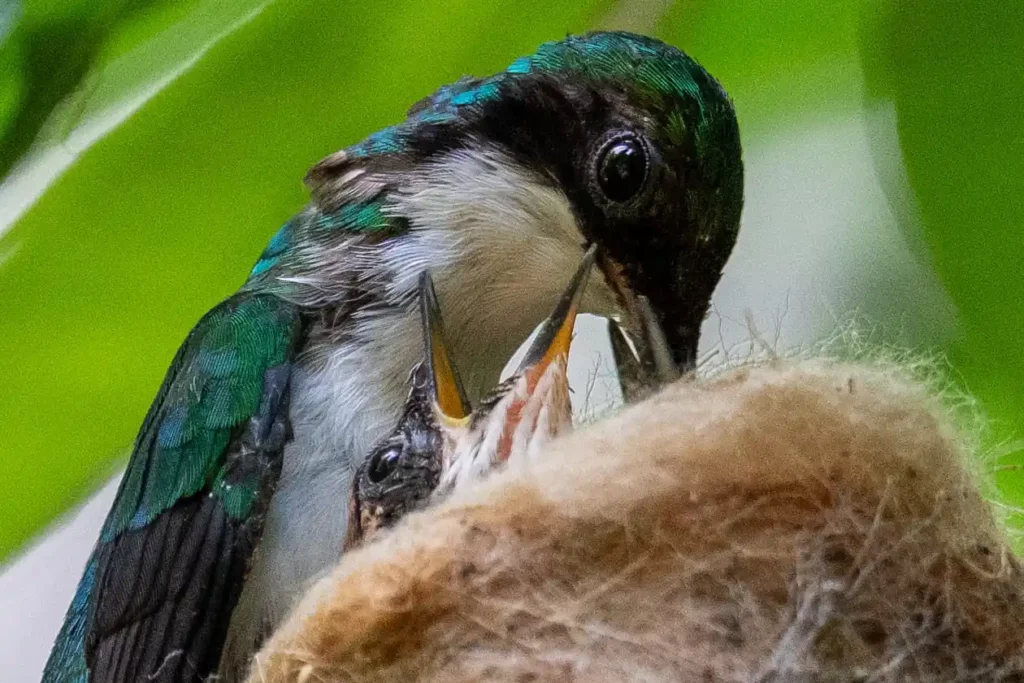Purple-crowned Fairy

Heliothryx barroti
Scientific Name
Trochilidae (Hummingbirds)
Family
Apodiformes
Order
Heliothryx barroti barroti
Subspecies. Found in southern Mexico to western Panama
Heliothryx barroti orienticola
Subspecies. Found in eastern Panama and northwestern Colombia
Range and Habitat
Geographic Range
The Purple-crowned Fairy is found in Central America and northern South America, ranging from:
-
Mexico (southern regions)
-
Guatemala, Belize, Honduras, Nicaragua, Costa Rica, and Panama
-
Extending into Colombia and northwestern Ecuador
-
Migratory Patterns
The Purple-crowned Fairy (Heliothryx barroti) is non-migratory and remains in its range year-round.
Preferred Habitat
It inhabits humid tropical forests, forest edges, clearings, and gardens with scattered tall trees, usually preferring the canopy.
Altitude Range
Most commonly observed in humid lowland rainforests and foothill forests on both the Caribbean and Pacific slopes.
Costa Rica Habitat
- Arenal Region (Alajuela) – Arenal Observatory Lodge
- Sarapiquí (Heredia) – La Selva Biological Station
- Tortuguero National Park (Limón Province)
- Carara National Park (Pacific Slope, Puntarenas Province)
- Monteverde (Cloud Forest edges, occasional sightings)
Conservation Status
Least Concern
Conservation Status
Population Status
Uncommon, but classified as Least Concern (LC) by the IUCN, with a stable population across its range.
Deforestation and habitat loss due to logging and urban expansion, pesticides and pollution.
Conservation efforts
Protected in several national parks and reserves (e.g., Tortuguero, La Selva, Arenal in Costa Rica).
Primary Threats
Deforestation and habitat loss due to logging and urban expansion, pesticides and pollution.
Identification
Purple-crowned Fairy
Rarity Level:
UncommonBest Viewing Times:
Early Morning (Dawn - 8 AM)
Size
Size: 10–11 cm (4–4.3 in). Weight: 5–7 g (0.18–0.25 oz).
Plumage
Bright emerald green upperparts, white underparts, a distinctive purple crown (most vivid in males)
Distinctive Features
Long, deeply forked black tail with prominent white outer tail feathers, and a straight black bill.
Sexual Dimorphism
Males have a bright purple crown that gives the species its name. Females lack the purple crown and generally have a longer tail.
Diet and Feeding Behavior
Primary Diet
- Primarily feeds on nectar: Prefers brightly colored, tubular flowers, insects & spiders, occasionally drinks from tree sap if available.
Foraging Techniques
- Uses hover-feeding, perch-feeding, aerial hawking, and gleaning techniques, while frequently moving between flowers instead of defending territories.
Feeding Times
- Most active at dawn and early morning (Dawn – 8 AM) when flowers are rich in nectar
Behavior Patterns
Purple-crowned Fairy
Lorem ipsum dolor sit amet, consectetur adipiscing elit, sed do eiusmod tempor incididunt ut labore et dolore magna aliqua.
Social Structure
Mostly solitary, like many hummingbirds.
Song and Vocalization
High-pitched, rapid “tsi-tsi-tsi” or “tsip-tsip” sounds. Often vocalizes while in flight or when interacting with other birds.
Courtship and Mating Ritual
Males perform aerial displays to attract females, often hovering in front of them while flashing their white outer tail feathers. After mating, the female is solely responsible for nest-building, incubation, and chick-rearing.
Territoriality
Not highly territorial like some other hummingbirds but may defend a preferred feeding site briefly.
Birdwatching Tips
Best Locations
Some of the best spots to see Purple-crowned Fairy in Costa Rica:
- Arenal Observatory Lodge
- La Selva Biological Station
- Tortuguero National Park
- Carara National Park

Best Time of the Year
March to July (breeding season, more active) and September to November (secondary nesting in some areas).
Common Behavior
This species often forages high in the canopy, so scanning treetops near flowering trees is key.
Recommended Gear
Binoculars and Camera with Zoom Lens (300mm+ or superzoom compact) – Helps capture details of its iridescent plumage and hovering behavior.
Breeding and Nesting Behavior
Breeding Season
Main breeding period: March to July (coincides with the start of the rainy season).
Nesting Sites
The female builds a small cup-shaped nest made of plant fibers, moss, and spider silk, often camouflaged with lichens. Nests are typically placed on a thin horizontal branch or in a fork, usually in the mid to upper forest canopy (5–15 meters above ground).
Clutch Size
Two tiny white eggs.
Incubation Period
{acf_breeding_and_nesting_incubation_period}
Parental Care
The mother sits on the eggs most of the day, leaving briefly to feed.
Did You Know?
Interesting Behaviors
– Insect Hunter: Unlike most hummingbirds, it doesn’t just rely on nectar—it actively hunts small insects by snapping them out of the air (a behavior called “aerial hawking”).
– Nest Camouflage Expert: The female builds a tiny, well-hidden nest, often attaching it to mossy branches or vines to blend into the surroundings.One of the Few Hummingbirds Without a Curved Bill!
Unlike many nectar-feeding hummingbirds, this species has a straight bill, allowing it to feed on a variety of flowers and even catch insects mid-air.
Forest Edge Explorer
Unlike some deep-forest hummingbirds, the Purple-crowned Fairy is often seen along forest edges, clearings, and gardens, making it a bit easier to spot